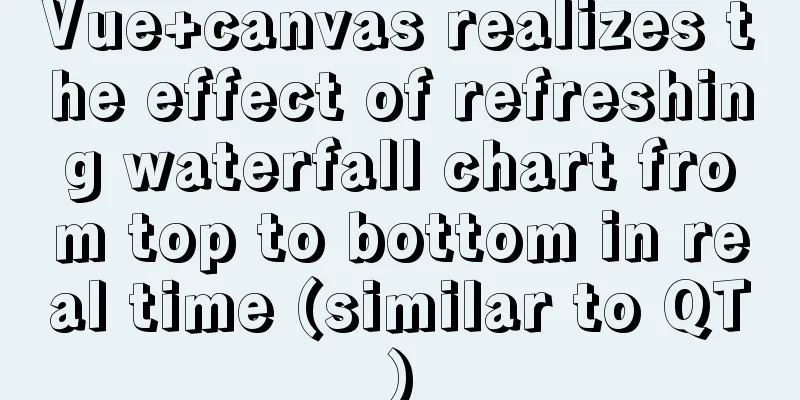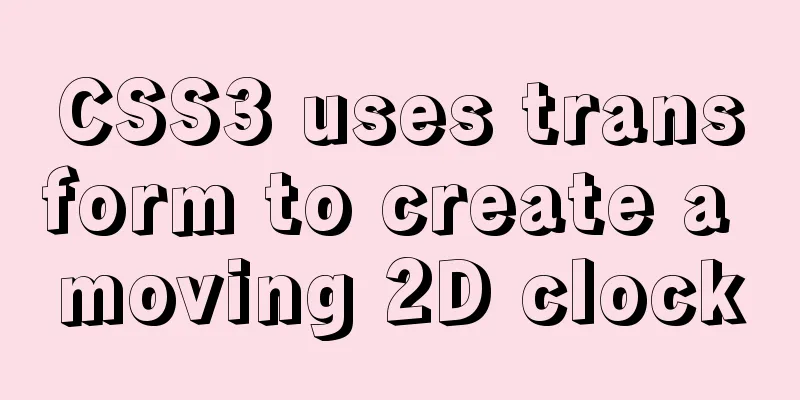Vue+canvas realizes the effect of refreshing waterfall chart from top to bottom in real time (similar to QT)

|
Without further ado, here is a demo picture. The functions implemented are: legend on the left, waterfall chart on the right, and data information corresponding to the current coordinates popping up when the mouse is moved (there is room for optimization, please feel free to play with it).
Plugins used in the illustration It is recommended to install the npm plugin colormap Waterfall chart bodyI won’t explain it here. They are all native tags and vue-bound events. You can encapsulate them into components according to the actual project situation. I have written them together here.
<template>
<div>
<div class="content">
<div class="neirong">
<!--Legend-->
<div class="legend">
<canvas ref="legend"></canvas>
</div>
<!--Waterfall Chart-->
<div class="waterFall" ref="waterFallContent"
@mousemove="waterFallMove($event)"
@mouseleave="waterFallLeave"
>
<canvas ref="waterFall"></canvas>
<!--Move the mouse into the pop-up box-->
<div ref="tip" class="tip"></div>
</div>
</div>
</div>
</div>
</template>Here is the Data used
<script>
export default {
name: "index",
data() {
return {
colormap: [],
legend: null,
waterFall: null,
waterFallList: [],
waterFallIndex: 0,
waterFallCopyList: [],
waterFallIntervals: null,
waterFallWidth: 0,
waterFallHeight: 0,
maxNum: 10,
minNum: 0
}
},
The following is a specific method. It is written roughly. Please read it carefully. If you find it useful, please take it away. If there are any shortcomings, you can modify it freely. I won't explain the method call here, leaving the page will destroy the timer.
mounted() {
let dx = this
dx.setColormap()
dx.createLegendCanvas()
dx.queryChartList()
},
destroyed() {
let dx = this
clearInterval(dx.waterFallIntervals)
},
Create a color library For details, please refer to the official website of the above plug-in for detailed introduction.
setColormap() {
let dx = this
let colormap = require('colormap')
dx.colormap = colormap({
colormap: 'jet',
nshades: 150,
format: 'rba',
alpha: 1,
})
},
Creating a Legend
createLegendCanvas() {
let dx = this
let legendRefs = dx.$refs.legend
dx.legend = legendRefs.getContext('2d')
let legendCanvas = document.createElement('canvas')
legendCanvas.width = 1
let legendCanvasTemporary = legendCanvas.getContext('2d')
const imageData = legendCanvasTemporary.createImageData(1, dx.colormap.length)
for (let i = 0; i < dx.colormap.length; i++) {
const color = dx.colormap[i]
imageData.data[imageData.data.length - i * 4 + 0] = color[0]
imageData.data[imageData.data.length - i * 4 + 1] = color[1]
imageData.data[imageData.data.length - i * 4 + 2] = color[2]
imageData.data[imageData.data.length - i * 4 + 3] = 255
}
legendCanvasTemporary.putImageData(imageData, 0, 0)
dx.legend.drawImage(legendCanvasTemporary.canvas,
0, 0, 1, dx.colormap.length, 50, 0, 200, dx.legend.canvas.height)
},
Creating a waterfall chart
createWaterFallCanvas() {
let dx = this
let waterFall = dx.$refs.waterFall
dx.waterFall = waterFall.getContext('2d')
waterFall.width = dx.waterFallWidth
waterFall.height = dx.$refs.waterFallContent.offsetHeight
},
Draw a single line image
rowToImageData(data) {
let dx = this
if (dx.$refs.waterFallContent !== undefined) {
let canvasHeight = Math.floor(dx.$refs.waterFallContent.offsetHeight / dx.waterFallHeight)
let imgOld = dx.waterFall.getImageData(0, 0, dx.waterFallWidth, canvasHeight * dx.waterFallIndex + 1)
const imageData = dx.waterFall.createImageData(data.length, 1)
for (let i = 0; i < imageData.data.length; i += 4) {
const cindex = dx.colorMapData(data[i / 4], 0, 130)
const color = dx.colormap[cindex]
imageData.data[i + 0] = color[0]
imageData.data[i + 1] = color[1]
imageData.data[i + 2] = color[2]
imageData.data[i + 3] = 255
}
for (let i = 0; i < canvasHeight; i++) {
dx.waterFall.putImageData(imageData, 0, i)
}
dx.waterFall.putImageData(imgOld, 0, canvasHeight)
}
},
Returns the Colormap color corresponding to the data
colorMapData(data, outMin, outMax) {
let dx = this
if (data <= dx.minNum) {
return outMin
} else if (data >= dx.maxNum) {
return outMax
}
return Math.round(((data - dx.minNum) / (dx.maxNum - dx.minNum)) * outMax)
},
Move the mouse into the waterfall chart
waterFallMove(event) {
let dx = this
let dataWidth = (dx.$refs.waterFallContent.offsetWidth / dx.waterFallWidth).toFixed(2)
let dataHeight = (dx.$refs.waterFallContent.offsetHeight / dx.waterFallHeight).toFixed(2)
let x = Math.floor(event.offsetX / dataWidth)
let y = Math.floor(event.offsetY / dataHeight)
try {
dx.$refs.tip.innerHTML = 'Value:' + JSON.parse(JSON.stringify(dx.waterFallCopyList[y][x]))
let xx = event.offsetX + 5
let yy = event.offsetY - 20
if (event.offsetX > 1300) {
xx = event.offsetX - 160
yy = event.offsetY - 20
}
dx.$refs.tip.style.position = 'absolute'
dx.$refs.tip.style.left = xx + 'px'
dx.$refs.tip.style.top = yy + 'px'
dx.$refs.tip.style.display = 'block'
} catch (e) {
dx.$refs.tip.style.display = 'none'
}
},
Move the mouse out of the waterfall chart
waterFallLeave() {
let dx = this
dx.$refs.tip.style.display = 'none'
},
Waterfall chart fake data simulation
queryChartList() {
let dx = this
dx.waterFallWidth = 1500
dx.waterFallHeight = 30
let data = []
for (let i = 0; i < 1500; i++) {
data.push(Math.floor(Math.random() * (20 - 1)) + 1)
}
if (dx.waterFall === null) {
dx.createWaterFallCanvas(data.length)
}
dx.rowToImageData(data)
dx.waterFallCopyList.unshift(data)
dx.waterFallIndex++
if (dx.waterFallIndex > dx.waterFallHeight) {
dx.waterFallCopyList.pop()
}
dx.waterFallIntervals = setTimeout(() => {
dx.queryChartList()
}, 1000)
},
Style Code
.neirong {
width: 1800px;
height: 100%;
margin: 80px auto;
display: flex;
justify-content: center;
}
.legend {
width: 25px;
height: 500px;
}
canvas {
width: 100%;
height: 100%;
}
.waterFall {
width: 1500px;
height: 500px;
position: relative;
}
.tip {
pointer-events: none;
display: none;
background-color: #0404049e;
border-radius: 10px;
color: #fff;
padding: 10px;
box-sizing: border-box;
}
At this point, the Demo can basically run without any errors. The code is not very advanced. I am also a beginner and this is my first time writing an article. I hope the big guys can give me some better suggestions and I will study hard. I also hope that friends who encounter similar requirements and have no ideas can learn from my experience of stepping into the pit and grow faster. This is the end of this article about how vue+canvas achieves real-time data refresh from top to bottom waterfall chart effect (similar to QT). For more related vue+canvas real-time refresh waterfall chart content, please search 123WORDPRESS.COM's previous articles or continue to browse the following related articles. I hope everyone will support 123WORDPRESS.COM in the future! You may also be interested in:
|
>>: Mysql 5.7.18 Using MySQL proxies_priv to implement similar user group management
Recommend
MySQL 8.0.21 installation steps and problem solutions
Download the official website First go to the off...
How to implement the prototype pattern in JavaScript
Overview The prototype pattern refers to the type...
In-depth understanding of Vue's plug-in mechanism and installation details
Preface: When we use Vue, we often use and write ...
Solution to 404 Problem of Tomcat Installation in Docker
Find the containerID of tomcat and enter the toma...
Example of usage of keep-alive component in Vue
Problem description (what is keep-alive) keep-ali...
Summary of new usage of vi (vim) under Linux
I have used the vi editor for several years, but ...
Vue+Websocket simply implements the chat function
This article shares the specific code of Vue+Webs...
Three ways to communicate between React components (simple and easy to use)
Table of contents 1. Parent-child component commu...
Install Centos7 using Hyper-v virtual machine
Table of contents introduce Prepare Download syst...
Detailed steps for adding hosts you need to monitor in zabbix
Add monitoring host Host 192.168.179.104 is added...
Detailed explanation of global parameter persistence in MySQL 8 new features
Table of contents Preface Global parameter persis...
Solutions to problems related to software package dependency reporting during installation in Linux
Table of contents background 1) Enable the keepch...
A brief analysis of MySQL locks and transactions
MySQL itself was developed based on the file syst...
Sharing tips on using scroll bars in HTML
Today, when we were learning about the Niu Nan new...
Directory permissions when creating a container with Docker
When I was writing a project yesterday, I needed ...










